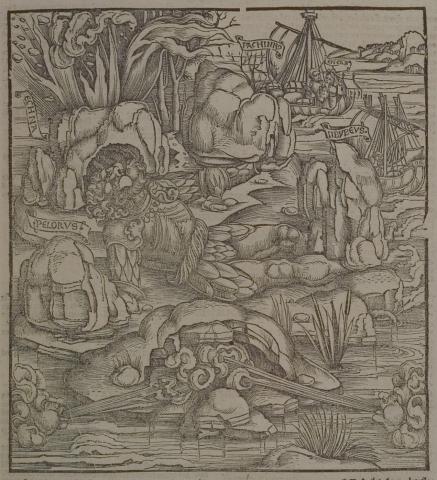Annotations
Aeneas, in the ship in the top right, sails past Sicily. In the center of the image is the Giant Enceladus; his feet are pinned down by Lilybaeum [Libybus], the west corner of the island, his left hand sits under Pachynum [Pachinn], in the lower east corner, and his right hand is held down by Pelorus, in the upper east corner. His head sits under Mt. Etna [Echna] (577-80), which is geographically situated between Pachynum and Pelorus. The giant spits smoke, fire and stones through the mouth of the volcano (570-7). Below the giant, two winds, one in each of the lower corners, blow into a cave, possibly a reference to the idea that Aeneas lands in the harbor opposite the winds (570-1). (Katy Purington)
Woodcut illustration from the “Strasbourg Vergil,” edited by Sebastian Brant: Publii Virgilii Maronis Opera cum quinque vulgatis commentariis expolitissimisque figuris atque imaginibus nuper per Sebastianum Brant superadditis (Strasbourg: Johannis Grieninger, 1502), fol. 203r, executed by an anonymous engraver under the direction of Brant.


Sebastian Brant (1458–1521) was a humanist scholar of many competencies. Trained in classics and law at the University of Basel, Brant later lectured in jurisprudence there and practiced law in his native city of Strasbourg. While his satirical poem Das Narrenschiff won him considerable standing as a writer, his role in the transmission of Virgil to the Renaissance was at least as important. In 1502 he and Strasbourg printer Johannes Grüninger produced a major edition of Virgil’s works, along with Donatus’ Life and the commentaries of Servius, Landino, and Calderini, with more than two hundred woodcut illustrations. (Annabel Patterson)